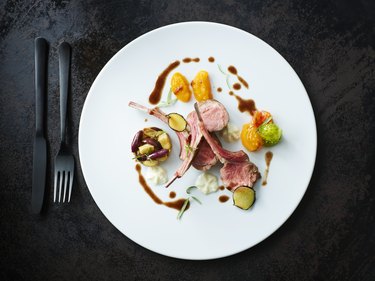
Lamb is a leaner red meat than beef and lets you add variety to traditional chop recipes. Depending on the age and type of your lamb, it can present a more gamey taste and lamb smell than the beef that you're used to.
But, bad lamb smell doesn't mean your lamb tastes bad. A few preparation and cooking tips will help you minimize lamb's gamey aroma while making it and let you and serve tender, delicious chops.
Video of the Day
Video of the Day
Lamb is a good source of zinc, iron, potassium and vitamin B12, according to the USDA. Older lamb, known as mutton, and certain breeds, may have a stronger aroma, so talk to your butcher about the types of lamb that they sell and which will have the least odor when cooking.
Prepping and Cleaning Lamb Chops
Fat holds flavor as well as odor, so trim as much excess fat as possible before cooking. The less fat that melts into the pan during the cooking process, the less aroma you'll have in the kitchen. Trim the fat when the meat is cold to make it easier to remove. Let the meat get to room temperature before cooking to allow it to cook evenly and faster.
Salting the meat can remove some of the blood, which is aromatic when it leaves the meat and fries in a pan. Soak the chops in water for 30 minutes to open the pores in the meat. Liberally salt both sides of the chops and let them sit for one hour. Scrape, then rinse, the salt from the meat before cooking.
You can also brine the chops by soaking them in a mixture of water, salt and vinegar, then rinsing before serving. Soaking the meat in milk for several hours, or overnight, will also pull some of the blood out of the chops. Rinse the milk and excess blood off the meat before cooking.
Seasoning and Lamb Smell
Another way to reduce the gamey lamb smell is to mask it with seasonings. Depending on your dish, you can use sweet or savory herbs and spices. Cinnamon, allspice, ginger and cloves are good choices for sweet dishes. Use herbs such as rosemary, sage, black pepper and time for savory dishes. Garlic has a strong aroma, while a dash of acidic lemon juice, often used to combat the smell of fish, can reduce the aroma in lamb.
Using a marinade, such as teriyaki or a combination of soy, ginger and pineapple, will add some steam during the cooking process, but will reduce the gamey flavor and aroma. According to the USDA Food Safety and Inspection Service, lamb meat can be marinated for up to five days before cooking.
Cooking Your Lamb
The less steam that rises from your pan, the less lamb odor you'll have in your kitchen and house. Cooking lamb with other ingredients, especially water-based vegetables and sauces, will create more steam that's released into the air.
Cook lamb chops by themselves by brushing them with oil, then seasoning them and putting a sear on each side at the beginning of the cooking process. Heat a skillet to high heat, then place the chops into the pan and let them cook for one minute to create a char on one side. This will keep flavor and juice inside the meat.
Flip the chops after one minute, using a tong or spatula to avoid poking the meat and letting blood run out. Flip one more time and finish cooking to your desired temperature. Covering the pan creates steam that will be released when you raise the lid to flip or finish, but reduces odor while cooking.
If you choose to bake your lamb chops, cover the baking pan in foil. This will keep odor in and help tenderize the meat. Adding vegetables or a sauce won't be a problem, since the steam will stay in a tightly sealed pan.
Regardless of your method of cooking, heat your lamb until the internal temperature reaches at least 145 degrees Fahrenheit — the minimum temperature for safe consumption of lamb meat, according to the Academy of Nutrition and Dietetics. Allow the meat to rest for three minutes before serving.
Was this article helpful?
150 Characters Max
0/150
Thank you for sharing!
Thank you for your feedback!